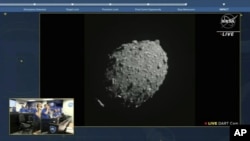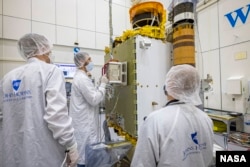A spacecraft from the American space agency NASA crashed into an asteroid about 11 million kilometers from Earth on Monday.
The mission is part of NASA’s Double Asteroid Redirection Test, or DART. The agency called it “the world’s first mission to test technology for defending Earth” against asteroids or other space dangers.
The spacecraft traveled at a speed of 22,500 kph. It hit the asteroid Dimorphos on Monday.
NASA watched the event live from the mission operation center in Maryland with cameras and telescopes on Earth. It hopes that the crash will re-direct the asteroid’s path. But it will be some time before the agency knows if it changed the asteroid’s orbit.
Asteroid target
Nancy Chabot is the mission team leader at Johns Hopkins University’s Applied Physics Laboratory, which oversees the effort. She said before the impact that “This isn’t going to blow up the asteroid.” Rather, she said, “This really is about asteroid deflection, not disruption.”
The target, Dimorphos, is about 160 meters wide. It completes one orbit around a parent asteroid called Didymos every 11 hours and 55 minutes. NASA engineers are hoping that the crash would shorten the time it takes for the smaller asteroid to orbit the larger one by several minutes. They note that even 73 seconds would be considered a success.
Although the impact only changes the asteroid’s orbit slightly, that will add up to a major re-direction over time, Chabot said. “So if you were going to do this for planetary defense, you would do it five, 10, 15, 20 years in advance in order for this technique to work.”
The two asteroids are not a threat to Earth. But the test shows whether crashing a spacecraft into an asteroid is an effective way to change its course, should an Earth-threatening asteroid be discovered in the future.
Dimorphos and Didymos are both very small compared to the Chicxulub asteroid that was estimated to strike Earth some 66 million years ago. The impact destroyed most of the world’s plants and animals including dinosaurs.
Dimorphos is among the 27,500 asteroids of all sizes under NASA observation. Many more have not been found as of October 2021. The space agency says that there is no known asteroid larger than 140 meters in size that has a chance to hit Earth in the next 100 years.
DART
The DART spacecraft has one instrument: a camera used for navigating and recording images until the time of impact and self-destruction.
DART is 1.3 meters long and weighs 570 kilograms. The vehicle is like a battering ram, a heavy object that is used to break through a door or wall, aiming for the 5-billion-kilogram asteroid. “Sometimes we describe it as running a golf cart into a Great Pyramid,” said Chabot.
DART is the latest of several NASA missions in recent years to explore and interact with asteroids. Last year, NASA launched a spaceship on a trip to the Trojan asteroid group orbiting near Jupiter. And the spacecraft OSIRIS-REx is returning to Earth with rocks collected in October 2020 from the asteroid Bennu.
Other countries, including China and Japan, have also launched their own asteroid missions.
I’m Mario Ritter, Jr.
Hai Do adapted this report for VOA Learning English from Associated Press, Reuters and NASA sources.
_____________________________________________________________________
Words in This Story
asteroid –n. one of many thousands of small rocks orbiting the sun
deflection –n. the act of causing something to change direction
disruption –n. the act of causing something to be unable to continue in a normal way
in advance –adv. ahead of time; before something happens
impact –n. the event of one thing striking another
______________________________________________________________________
We want to hear from you.
We have a new comment system. Here is how it works:
- Write your comment in the box.
- Under the box, you can see four images for social media accounts. They are for Disqus, Facebook, Twitter and Google.
- Click on one image and a box appears. Enter the login for your social media account. Or you may create one on the Disqus system. It is the blue circle with “D” on it. It is free.
Each time you return to comment on the Learning English site, you can use your account and see your comments and replies to them. Our comment policy is here.











Forum